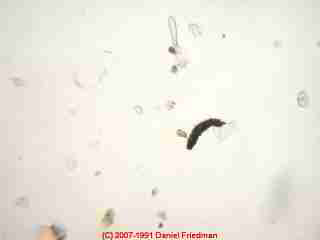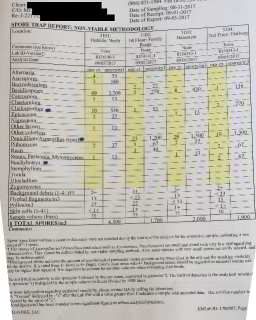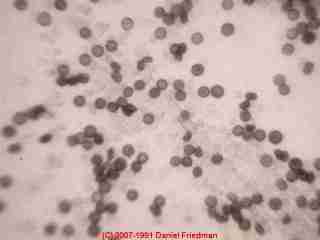 Reports of Dust Particle or Mold Levels in Buildings
Reports of Dust Particle or Mold Levels in Buildings
- POST a QUESTION or COMMENT about how to report the density or level of mold or other particles found on indoor surfaces or in indoor dust samples
How to report levels of mold contamination in buildings:
This article discusses how to report levels of mold in buildings in order to promote consistent use of surface particle dust or mold test adhesive tape sample descriptive language among microbiology lab and field investigation professionals.
Here we define levels of significance of mold findings in test results.
The definitions that follow are a work in progress and need support by example lab photomicrographs and quantitative study. Our photographs here illustrate three very different densities of mold particles found in a series of indoor environmental samples.
InspectAPedia tolerates no conflicts of interest. We have no relationship with advertisers, products, or services discussed at this website.
Useful Definitions of Mold or Other Particle Densities in Indoor Environmental or Dust Samples
 If collected by an expert during a careful visual inspection, and thus if
representative of conditions in a building, surface particle
samples collected in buildings provide an important building diagnostic
which can be expected to be more reliable than other popular mold
testing methods including some which, sadly, may be little more than junk science.
If collected by an expert during a careful visual inspection, and thus if
representative of conditions in a building, surface particle
samples collected in buildings provide an important building diagnostic
which can be expected to be more reliable than other popular mold
testing methods including some which, sadly, may be little more than junk science.
Take a look at our photograph of three adhesive tape sample collections on a moldy drywall surface in a laundry room. These samples are collected just one to 1.5" apart. Yet each of them will collect a completely different mold genera and species!
See details at DUST / MOLD TEST KIT INSTRUCTIONS
Watch out: in the case of drywall that has become wet from a flooded or wet floor, the moisture gradient in the drywall drops as we check levels higher above the wet floor or flood-water level.
At MOISTURE GRADIENTS & MOLD we explain why we find different mold genera/species at different locations on moldy drywall.
A result of these moisture gradients is that completely different mold genera-species, each preferring different moisture levels, may grow at different heights on the drywall - sometimes just inches apart as in this photo.
In a compelling demonstration of the importance of mold sample location selection, for the three samples shown above, collected just an inch or so apart, in the lab we confirmed three different mold from the bottom up: Stachybotrys chartarum, Aspergillus sp., and Cladosporium sp.
Of these three molds, the Stachybotrys chartarum is most often the mold which consumers fear and which they ask their "mold expert" to find. But while Stachybotrys is indeed potentially harmful, Aspergillus sp. is far more likely to be airborne, to be breathed deeply into the lungs, and to be hazardous throughout a building where equally-sized reservoirs of the two molds are present. Therefore focusing on testing for "black mold" in buildings is a risky mistake.
Accuracy vs Precision: Nonsensical vs. Reasonable Reports of Mold Levels or Concentrations on Surfaces
 Therefore quantitative reporting of mold concentrations found on surfaces (such as
spores/M3 or CFU/M2 on a surface) in buildings should not be attempted except for narrow purposes of scientific research under controlled conditions.
Therefore quantitative reporting of mold concentrations found on surfaces (such as
spores/M3 or CFU/M2 on a surface) in buildings should not be attempted except for narrow purposes of scientific research under controlled conditions.
Shown at left, an example of test results for an airborne mold test. [Click to enlarge any image]
Why Some Mold Tests Are Not Helpful
OPINION: "air tests" for mold are unreliable: the actual mold spore count detected in an air sample can vary several orders of magnitude depending on just when, where, and how how a test is conducted, so a number of 270 could be 2.7 or 27,000 in actual truth.
Worse, when an air test finds high airborne problem mold spore counts that are high enough that it's very likely that there is an indoor mold problem needing to be addressed, such a report does not really tell us where the mold reservoir is, if there is one that needs action. So it is not telling us what needs to be done. Such a report is not prescriptive.
The building owner may have to pay a similar "mold inspection" fee all over again to actually find out what mold cleanup work is needed.
So the airborne mold count number is not so helpful unless accompanied by a competent, thorough onsite inspection to find the problem mold reservoir OR to tell you that enough looking in the most-suspect areas means that further action isn't justified.
Other types of "mold tests" have accuracy limitations too.
The variation in tape and other sampling methods is explored separately
at MOLD TESTING METHOD VALIDITY.
Once we are informed that only about 10% of the 1.5 million or so mold genera and species will grow on any culture whatsoever, even less credible than spores/M3 is CFU/M2 on a surface - as we elaborate
If an indoor particle sample is representative of the area being inspected, then the identity of significant or dominant particles present is important information about conditions in the building.
If the indoor sample is not collected with intelligence, it is frankly, unreliable as a characterization of what contaminants are actually dominant or important in the building.
So can we make any use of a mold test report? Yes, maybe.
So do any mold numbers make sense? In our opinion, yes, as rough approximate counts, not as precise numbers.
In particular, very high counts of problem mold types indoors are almost certainly indicative of an indoor mold problem that needs to be addressed.
But low indoor mold counts might simply have missed a significant mold problem because of when, where, and how the test was conducted.
Experience tells us that there are general guidelines for airborne mold levels that suggest that a building is or is not harboring a significant, if hidden, problem mold reservoir.
See AIRBORNE PARTICLE & MOLD COUNT NUMBER GUIDE for general guidelines to what constitutes "high indoor mold counts".
Watch out: as we explain below at ENVIRONMENTAL TEST ERROR TYPES, while a high mold or other particle count number almost certainly has meaning, depending on test circumstances and how samples are collected, low numbers may be very unreliable.
Why then do we see these highly precise but inaccurate mold counts or dust counts? Some lab directors explain that such numbers are a response to marketing competition. "If we don't give numbers someone else will".
For details see ACCURACY vs PRECISION of MEASUREMENTS.
Reasonable & Useful Definitions of Indoor Mold or Dust Particle Levels: Not detected, Incidental, Present, Significant or Dominant
When we examine surface test samples collected in buildings, properly obtained by following a visual inspection of the building and by using a clear, consistent sampling procedure, then we can report the following Non-Quantitative Particle or Mold Levels Based on Samples.
Our mold level terms "Significant/Dominant, Present, Incidental" are defined below. Others may use similar terms such as "heavy, medium, light", or "high, moderate, low. "
- Particles not detected
in a dust or environmental air or surface sample means that the particle named was below the detection limit of
the inspection, sampling, and examination methods used in the field and
laboratory. It does not mean that none of these particles are present in
the building.
Watch out: "Particles not detected" does not mean that none of these particles are present in the building. It means that the particles were not detected in the sample. The extent to which we are confident that the particle sample accurately represents building conditions is the extent to which we can generalize from "not detected" to "not present" in a building.
 Particles Incidental in a
sample
Particles Incidental in a
sample
means that we found only occasional, or low-levels of fungal spores in the sample provided-below the level we usually find in indoor air samples in buildings where there has been a history of leaks, flooding, or known mold contamination.
This is a positive description of the quality of indoor air insofar as fungal spores are concerned, but one cannot unequivocally conclude that there is no possible health hazard present because:
1. individual exposure, sensitivity, and health status vary widely;
2. even a zero count does not guarantee that a particle is not present in the building.
It means only that that particle was not in the sample provided.
A careful, expert look at the building may disclose particles that an occupant or inspector was unable to recognize and thus did not send to the laboratory for determination. Particles Present
Particles Present
in a sample means that these particles were frequently present in the sample.
They are less likely to be of significance to occupants of the building than "Significant/Dominant" particles except when particles named
1. are particularly allergenic or toxic
2. suggest an undiscovered building problem.
If the building has a history of leaks, water entry, or other hidden moisture problems, the presence of even a few toxic or allergenic spores which are not often found in outdoor air samples may indicate a hidden problem.
If control samples from outdoors or from non-complaint areas of a building do not show the presence of these particles, further investigation is in order to determine if there is a significant presence elsewhere in the building than from where this sample was taken. Particles
Significant or Dominant in a sample
Particles
Significant or Dominant in a sample
means that within the sample these particles were the most-frequent particle in the sample or that the particle was present in most or all sample focal fields under the microscope at 400x or higher magnification.
Problematic mold or allergenic particles listed in this category are likely to be of significance to occupants in the building.
Where the particle is a mold genera or species capable of growing indoors a finding at this level makes it likely that there is one (or more) mold reservoir or mold colony in the building. This term refers to the sample content itself.
A visual inspection of the property is needed to determine if the mold is present in extensive or large areas in the building.
When the significant/dominant particle(s) present is/are allergenic or toxic mold or an allergen, building investigation to find and clean/remove the problem source is needed
Guide to Mold and IAQ Investigation Reports
- MOLD INVESTIGATION REPORTS - what to look for in a toxic mold field investigation report and mold test laboratory report ©
- MOLD LAB REPORTS - what to look for in a toxic mold test laboratory report ©
- MOLD LEVEL REPORTING in Mold Test Samples of Surfaces in Buildings - suggested non-quantitative definitions
- SICK HOUSE IAQ QUESTIONNAIRE used to collect occupant and Building information that may aid the investigator
This article explains how to report and understand the significance of the level of particles of mold or other particles found on indoor surfaces.
Readers should also see MOLD TESTING USING ADHESIVE TAPE where we provide a quick tutorial on "Mold Testing: Bulk or Tape Surface Samples and their interpretation"
If collected by an expert during a careful visual inspection, and thus if representative of conditions in a building, surface dust or settled dust and airborne debris particles collected in buildings provide an important building diagnostic which can be expected to be more reliable than other popular mold testing methods including some which, sadly, may be little more than junk science.
See DUST / MOLD TEST KIT INSTRUCTIONS
See MOLD TESTING METHOD VALIDITY and also
see MOLD CULTURE TEST KIT VALIDITY.
If an indoor particle sample is representative of the area being inspected, then the identity of significant or dominant particles present is important information about conditions in the building.
Classes of Testing or Statistical Errors Applied to Mold or Other Environmental Tests, Inspections, Reports
At ENVIRONMENTAL TEST ERROR TYPES we explain in more detail the classes of testing or statistical errors and how in a practical sense they apply to mold or other environmental inspection, testing, lab and reporting procedures.
Type 1 and Type 2 errors are defined along with practical examples taken from building inspection and testing for mold contamination.
Reader Comments, Questions & Answers About The Article Above
Below you will find questions and answers previously posted on this page at its page bottom reader comment box.
Reader Q&A - also see RECOMMENDED ARTICLES & FAQs
Question: mold cultured from jute carpets
(June 3, 2014) Anonymous said:
we have some jute carpets which have been tested and the results are
Microfungi 2% malt --- 34 cfu/ 100cm2
microfungi DG 18 --- about 450 cfu/100 cm2
The mould is not visible to the eye.
Are these acceptable levels for Europe
Or are these dangerous levels
pl advise at my emai - deast123@gmail.com
RAJIV BAHL
Reply:
At page end article links you can find a link to an article on MOLD EXPOSURE STANDARDS that includes the EU.
But your mold culture test is not useful in this application, nor in my opinion valid.
Only about 10 % of molds will grow in culture of any formula, so relying on cultures to screen for mold is potentially 90% wrong from the outset.
See details at MOLD CULTURE TEST KIT VALIDITY
...
Continue reading at MOLD TESTING & SAMPLING MISTAKES for more examples of how mold testing goes wrong, or select a topic from the closely-related articles below, or see the complete ARTICLE INDEX.
Or see these
Recommended Articles
- ACCURACY vs PRECISION of MEASUREMENTS
- ACCURACY OF AIR TESTS for MOLD - home
- ACCURACY of MOLD TESTS - all types of mold tests
- AIRBORNE PARTICLE TEST SAMPLING CASSETTE STUDY
- AIRBORNE MOLD SPORE COUNT GUIDE - home
- AIRBORNE PARTICLE LEVELS vs IAQ - home
- AIRBORNE MOLD COUNT VALIDITY
- AIRBORNE PARTICLE ANALYSIS METHODS
- AIRBORNE PARTICLE COUNT VARIATION CAUSES
- AIRBORNE PARTICLE COUNT VARIATION EXTENT
- AIRBORNE PARTICLE COUNT VARIATION EXTENT
- AIRBORNE PARTICLE COUNTS in DUCTWORK
- AIRBORNE PARTICLE COUNTS vs SAMPLER HEIGHT
- AIRBORNE PARTICLE COUNTS vs WINDOWS, DOORS
- AIRBORNE PARTICLE SIZE TABLE
- FALSE NEGATIVE MOLD TEST RESULTS
- MOLD CULTURE TEST ERRORS
- MOLD CULTURE TEST KIT VALIDITY
- MOLD EXPOSURE RISK LEVELS
- MOLD EXPOSURE STANDARDS - home
- MOLD INVESTIGATION REPORTS
- MOLD LAB REPORTS
- MOLD LEVEL REPORTING
- MOLD TEST PROCEDURES
- MOLD TESTING METHOD VALIDITY
- MOLD TESTING & SAMPLING MISTAKES
- USES of AIRBORNE PARTICLE SAMPLING
- VISUAL INSPECTION & HISTORY of MOLD
Suggested citation for this web page
MOLD LEVEL REPORTING at InspectApedia.com - online encyclopedia of building & environmental inspection, testing, diagnosis, repair, & problem prevention advice.
Or see this
INDEX to RELATED ARTICLES: ARTICLE INDEX to MOLD CONTAMINATION & REMEDIATION
Or use the SEARCH BOX found below to Ask a Question or Search InspectApedia
Ask a Question or Search InspectApedia
Try the search box just below, or if you prefer, post a question or comment in the Comments box below and we will respond promptly.
Search the InspectApedia website
Note: appearance of your Comment below may be delayed: if your comment contains an image, photograph, web link, or text that looks to the software as if it might be a web link, your posting will appear after it has been approved by a moderator. Apologies for the delay.
Only one image can be added per comment but you can post as many comments, and therefore images, as you like.
You will not receive a notification when a response to your question has been posted.
Please bookmark this page to make it easy for you to check back for our response.
Our Comment Box is provided by Countable Web Productions countable.ca
Citations & References
In addition to any citations in the article above, a full list is available on request.
- In addition to citations & references found in this article, see the research citations given at the end of the related articles found at our suggested
CONTINUE READING or RECOMMENDED ARTICLES.
- Carson, Dunlop & Associates Ltd., 120 Carlton Street Suite 407, Toronto ON M5A 4K2. Tel: (416) 964-9415 1-800-268-7070 Email: info@carsondunlop.com. Alan Carson is a past president of ASHI, the American Society of Home Inspectors.
Thanks to Alan Carson and Bob Dunlop, for permission for InspectAPedia to use text excerpts from The HOME REFERENCE BOOK - the Encyclopedia of Homes and to use illustrations from The ILLUSTRATED HOME .
Carson Dunlop Associates provides extensive home inspection education and report writing material. In gratitude we provide links to tsome Carson Dunlop Associates products and services.

